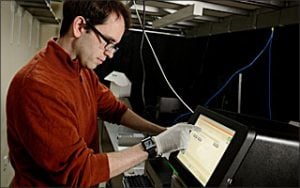Cutting through the noise of DNA Sequencing

The Human Genome Project, a 13-year effort to map the complex DNA sequences that are the building blocks of our bodies and biological systems, was a landmark in genetic understanding. Critical as it was, the project only described the sequences, not the way DNA behaves and interacts with other elements to develop organisms.
As a rough analogy, it was like obtaining a music album that blared, all at once, every piece of music it contained.
What’s next is discovering a way of playing that DNA-based album so the individual notes, measures, and tracks are heard—getting a dynamic understanding of the structures and processes that create healthy humans. Just as importantly, researchers want to see what causes the genetic music to become the cacophony that is cancer, mental illness, and other unwanted results.
BME Assistant Professor Winston Timp is working on a way of doing so through something called nanopore technology. Advances in testing methods allow scientists to pass DNA through holes just one nanometer in diameter. Using current measurements, Timp and his team will use a novel method to read the chemical structures modifying the DNA strands.
To further that work, Timp was selected by the Provost’s Office to receive a $75,000 Catalyst Award. The grant is intended to help early career faculty members pursue particularly promising research.
Timp’s work is not without precedent. As early as 1983, scientists understood that methylation, a process by which methyl groups are added to DNA, was important to cancer development. Timp’s work will include forays into chemical structures and processes that are less well understood. His background—bachelor’s degrees in biochemistry, chemistry, electrical engineering, and physics, as well as a master’s degree and doctorate in electrical engineering—suits him well for the task at hand.
While the understanding they gain will be at a molecular level, the potential payoffs are tectonic in effect. As it is, physicians have a relatively rudimentary ability to anticipate the onset of cancer. Once cancer manifests itself in organs such as the pancreas, there’s little that can be done to treat it. But deep knowledge of cancer’s patterns on a genetic level would transform screening so that the pancreatic risk would be caught early, possibly allowing effective drug treatment to stop the carcinogenic process before it becomes irreversible.
– Michael Blumfield
